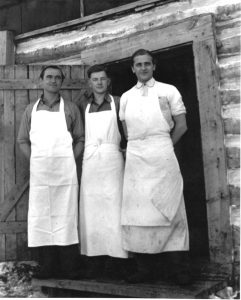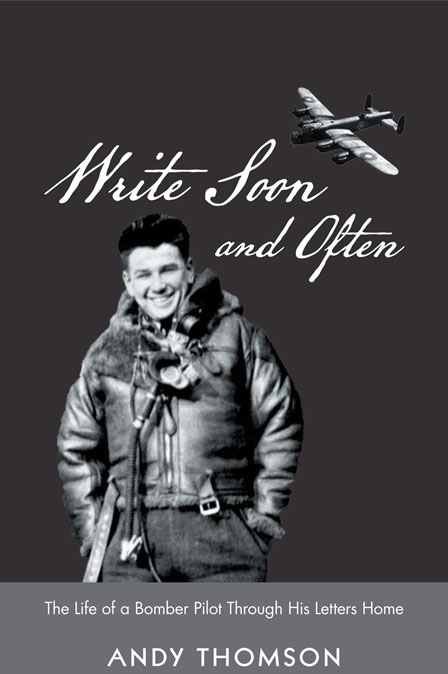A Pulp Camp for German POW’s
In December of 1945, a prisoner-of-war camp was established in the northwestern corner of Antrim Township, about 16 kilometres by road from the Sheahan station. I was fortunate to get to know Bill Blight, who told me much about the lumber history of our area. He began as a clerk with the KVP Company in 1945 at a POW camp and worked for them and the companies succeeding KVP until he retired. Although the European part of the war was over on May 8, 1945, the POWs were not returned to their homeland for another two years because both Germany and England (sometimes used as a stop-over for POWs) were unable to repatriate prisoners due to disastrous post-war conditions in Germany. See and hear Bill’s account of the POW and logging on the Spanish River: http://bit.ly/2HxzTjb

Three POWs who worked in the cookery at Camp 103. Courtesy of Bill Blight.
Because pulp camps in Ontario were short of labour, the Canadian government asked for volunteers in an Alberta POW camp to work in Ontario. They were detained in a large camp with little to do, so the opportunity to work in the bush appealed to 330 of them. They came from Alberta by train and were dropped off at Ramsey, Sheahan, and Cartier. Camp 103 at Sheahan received 105 POWs and, along with 45 civilians, they built the camps under the supervision of the KVP of Espanola and four military guards.
For their work, the POWs were paid a daily rate of 50 cents if they cut 1¼ cords, and a dollar if they cut 2 ½ cords of pulpwood. The pulp was hauled out of the bush by horse and then taken by trucks to the Spanish River. According to Blight, they were pretty decent guys. He had a few stories to back that up. Just before Christmas, there was to be a changing of the guard, and for eight hours, the camp was without military guards. The civilian managers remained, including Blight, who was a sixteen-year-old just out of high school. The guards left on the morning train and their replacements were to come on the afternoon train. During that day, Blight noticed there was quite a gathering of the prisoners at the guardhouse, and when he went to investigate, he saw the POWs had the guards’ guns out on the table and were examining and discussing them. However, Blight didn’t have to worry. They were just comparing our guns to the ones they used to have. When he asked them to leave, they did without incident.
There were times when a German prisoner became injured and had to be taken to Sudbury for medical treatment. Generally, two of the four guards accompanied him and they all stayed in a Sudbury hotel waiting for the return train to Sheahan the following day. Often, the guards would buy a case of beer and as a result, were hung over the next day. Now it was the prisoner who looked after the guards, carrying their guns. They were hardly the stereotypical prisoners of war we have become accustomed to hearing about.
As at any isolated bush camp, the prisoners had monthly visits from a doctor from the Sudbury Clinic. My father was one of the doctors and he told me about one of his experiences. One of the POWs fancied his watch, and asked him if he would trade it for a replica of the Santa Maria, Christopher Columbus’ three-mast ship, that he had meticulously carved out of a block of white pine. Trading was the only way these prisoners could obtain items, as they were never given cash to spend. Once my father saw what the prisoner was offering he accepted it. It was an incredible work of art, with detailed rigging, sails, a steering wheel that turned the rudder, and a few miniature sailors on the deck. Every aspect of the boat was made to scale in fine detail. It became a favourite toy of our family for years. Unfortunately, we didn’t quite appreciate the magnitude of the treasure and so it became a bit battered, experiencing the rough voyage through two generations of Thomson boys.
Blight kept in touch with a number of the former POWs and a few years later, he wrote to one of them, Walter Gerber, about his memory of coming to camp for the first time. “I arrived at Camp 103 mid-December of 1945 to work as an assistant clerk. I will always remember Christmas Eve, a cold, still night with the stars shining and carols being sung in the barracks. I think I was as lonesome for home as you were…. In the following years I went back to that camp several times, and also worked on the log drives down the river.”
In April of 1946, the POWs were sent to England, where they worked another two years before returning to Germany. In 1996, one of the prisoners, Herbert Ertle, got in touch with E.B. Eddy (the successor to KVP) and came to Canada. When he reached Espanola he was flown in by helicopter to the camp with Blight. They didn’t find much of Camp 103, as it had been burned down in the 1960s. All that was left was some rusted steel and the outlines of the log buildings. Blight returned a few years later with my nephew, Allen Day, and could barely find anything, due to the deterioration and forest regrowth.


{ 11 comments… read them below or add one }
Bill Blight is my father. Unfortunately he passed away in 2009
I was going through some old emails and saw your email. I met your aunt, your father’s sister (sorry can’t remember her name) on a trip up the Labrador coast in 2016. WE were out on a rocky shore and she commented that it reminded her of the type of rock where she grew up. When she said Espanola, we were soon catching up on our common past, and of course I asked her if she knew a Bill Blight! Your father was a very generous man and helped me a lot. I joined the Friends of the Spanish River and bought one of the calendars they published. He also helped produce and narrated a DVD on logging on the Spanish River. Thanks for getting in touch.
Hope you are keeping well.
Andy
I just came across a photo of my mother at 6 yrs of age with a dog named Cubby, and behind photo it says was taken at K.V.P camp Ramsey, Ontario 1945
My grandparents Harry and Aurore Malleau had a logging camp business in those area sadly I dont know the name of it.
Hi Lynn,
Here is a map of the KVP camps in the Spanish River watershed. There was a Camp 500 near Ramsey. Have a look through this website.
There is another unpublished source by Tom Thorpe entitled “A Review of the Logging and pul[p Operations in the Sudbury District, 1901 – 1950” which may be of help. Was there anything specific you were looking for?
Andy
Hi. This is fascinating. I have two stories (and pictures) of my grandparents Raymond and Alma Nadon who lived at one of those camps. My grandfather was a cook there. And my grandmother already had her first child. I can’t be sure they were in Sheahan. Maybe it was Sultan. I’m not sure. My grandmother simply described it as “way up in the bush”. Given that they come from Espanola and Sault. Ste. Marie area I think it’s a reasonable guess that it could’ve been Sheehan.
At any rate, she described two incidents that surprised me… especially since she told them so “a matter of fact” like..
1. Some German POW‘s who were helping with the cooking grabbed cutlery and were “rebelling” against being told what to do (presumably by my grandfather). One of the cooks jumped away from them and burned his hands on the grill while doing so. My grandmother said she started “yelling my head off” and “scolding them” as I held my baby. They backed off at that point. Later, she said the other Germans identified the key rabble-rouser and “dealt with him themselves” and excluded him from the group in some sort of temporary confinement. I asked, “wasn’t there any soldiers to guard them a s deal with all this? I mean anything could’ve happened!” She said, “Oh no, it was way up in the bush, there was no reason to guard them… “!?!?
The other story involves my grandmother, again with her infant in tow, walking into the kitchen to find “Ray and a big German wrestling and grappling him.” She said “I started yelling at them and screaming” and the German let go of Ray (my grandfather). Apparently, Ray was really mad at my grandmother for doing that though because “he thought he could get the better of the big Kraut.”
Again, I have some pics of them working abt lumber camps in the 40’s that I’d love to share… and I’m also wondering if their are any sort of personnel records as to who resided and lived at these camps so that I can verify my grandparents being involved there. Thanks for your work!:)
Craig,
Thanks for your information. I believe there were only two camps for Germans who came east from Alberta – one at Nays, west of Marathon, and the one at Sheahan. As you have read in my blog, these volunteers came to work in pulp camps and according to Bill Blight who worked there as a clerk, they were pretty good guys. But there may have been a couple of bad apples so stories like your grandmother are possible. Have a look at Bill’s movie he made about the camp and see if any of your photos match some of his: http://bit.ly/2HxzTjb
If you want to share your photos there is a Facebook site Historic Northern Ontario where you could post them.
Thanks again for sharing your stories.
Regards,
Andy
Does anybody have any info on the logging camp that was at mule lake north of cartier ont on the 700 kvp road thank you
Does anyone know where I could get a copy of the dvd Bill Blight made on the Spanish river?
I may have it but it will take some digging and will get back to you asap.
Andy
I can’t find the dvd video but I have a copy of the 2000 calendar he produced for the Friends of the Spanish River. Try posting a request on one of the many Facebook history groups.
Hello everybody,
in 1954 my parents immigrated from Germany to Canada.
My dad was an POW from 1943 to 1946 and spend time in Alberta and later at the Lake Head.
A former guard of my dad Mr. Robinson, had contact after the war and guided my family to the Chapleau area, where we ended up in Devon and at an former POW Camp on Lake Borden at camp 1.
If anybody has a clou what the background of this camp was, let me know. Thank you, Merci and cheers, Joe